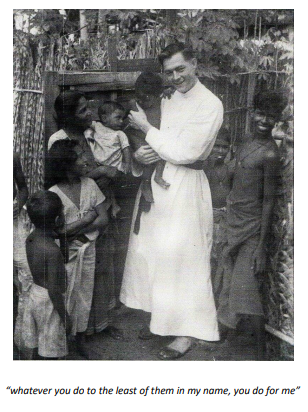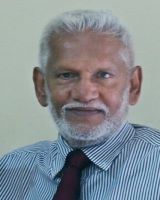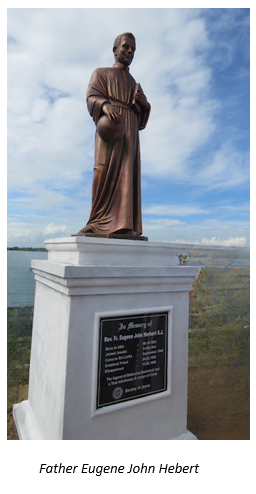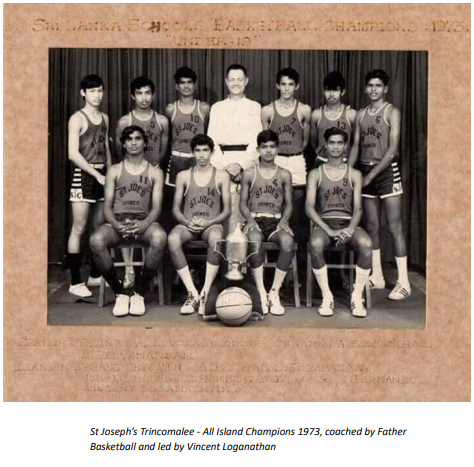Fr Eugene J Hebert – A life to be remembered.- By Capt Elmo Jayawardena

 The monument with engraved details of someone stands like a sentinel. It can be seen by anyone entering Batticaloa town from the lakeside. At the Garden Park some faithful followers had erected the statue and painted in colours of haunting old gold. It is to honour a priest who no longer walks this planet due to a senseless incident. The figure is clad in a flowing ankle length robe. The sculpted face is familiar to those who had known him. His signature ghost of a smile is depicted correctly is what anyone who knew him would say. On the left hand, the statue holds a Holy Bible. On the right hand is a basketball, cradled fondly to tell the world the man and the game were synonymous. It whispers in all simplicity whose statue it is – a dedicated missionary who served the ‘least of them’ for a lifetime. On the flipside he was a coach, by all standards a lover of basketball, and undoubtedly the godfather of the game in the Eastern Province.
The monument with engraved details of someone stands like a sentinel. It can be seen by anyone entering Batticaloa town from the lakeside. At the Garden Park some faithful followers had erected the statue and painted in colours of haunting old gold. It is to honour a priest who no longer walks this planet due to a senseless incident. The figure is clad in a flowing ankle length robe. The sculpted face is familiar to those who had known him. His signature ghost of a smile is depicted correctly is what anyone who knew him would say. On the left hand, the statue holds a Holy Bible. On the right hand is a basketball, cradled fondly to tell the world the man and the game were synonymous. It whispers in all simplicity whose statue it is – a dedicated missionary who served the ‘least of them’ for a lifetime. On the flipside he was a coach, by all standards a lover of basketball, and undoubtedly the godfather of the game in the Eastern Province.
Father Eugene John Hebert was born 100 years ago, on the 9th of October 1923. He hailed from the outskirts of Louisiana from the small town of Jennings. At the age of 25, he arrived in Sri Lanka (then Ceylon) in the September of 1948. During that time, there were more than a dozen American Jesuit Missionaries working in the North and East of the island, mainly covering Trincomalee and Batticaloa. The novice Hebert was attached to the St. Sebestian’s Orphanage, Kallady. He then went to India and was ordained as a full-fledged Jesuit priest in 1954.
Yes, the young man was committed with deep faith to serve his fellow beings, and endeared himself deep into the souls of the people in the north and east. He taught and assisted them in all possible ways to uplift their living standards. These were poor people, continuously straddled with limited resources and fewer solutions. Father Hebert did muster the best of his abilities to preach solace and sanity, especially to those in his congregation who lived below the proverbial poverty line.
The Bible that is carried on the left hand of the Garden Park statue is for us to remember the priestly side of Father Hebert.

The right hand treasures a basketball! Anybody in Sri Lanka who had anything to do with the game from the 60’s onwards would know Father Hebert. He was the best trainer and team handler I saw in local basketball games. Rival coaches feared him, the whistle blowers were scared of him, the players all learned from him, and the spectators loved him. No wonder he was fondly known as ‘Father Basketball’, and remembered to this day with awe as an unforgettable gladiator in the cager fraternity.
Yes, I am glad that along with the Bible, the statue also carries a basketball. Doesn’t that say it all?
I first met Father Hebert in 1963 at the All-Island Schools Basketball Championship in Batticaloa. I was a player for St Sebastian’s and Father Hebert came from Trincomalee with a team from St Joseph’s College. I still remember some of Father Hebert’s players, Anton Nadarajah, Godfrey Tissaveerasinghe and Bimal Thambiah. They did not win the championship but won many hearts playing a different brand of basketball that Father Hebert had taught them to play. The team was young, and it was the fighting spirit that was in them that astounded everyone who saw them play. It was all their coach’s work; it was Father Hebert who made them play like little demons on the court.
I saw the Trinco Boys come again to Moratuwa in 1965 and win the All-Island championship. This time Father Hebert’s team was unbeatable. I do recall Tsang Shi Wang, Freddy Walsh, Joseph Christie and Vasantharaj. The others I forget, it was a long time ago. The team played excellent basketball whilst Father Hebert was on full volume with his ‘fog horn’ voice running the game from the sidelines. The Trinco Josephians went home as champions. Father Hebert certainly deserved that victory. It was only the beginning. His teams continued to play attractive basketball and won many championships.
My meetings with Father Hebert after that were on the opposite benches of the court when we were rival coaches. I was coaching Moratuwa, and he was coaching Batticaloa. We played against each other in many school matches, and at the Nationals where he coached Eastern Province, and I coached the Mercantile team. I did win some against him. But on the total tally he beat me hands down. Losing to the ‘Father Basketball’ was no shame and winning against any team he coached was certainly a laudable hallmark victory.
Pronouncing Father Hebert’s name was a problem to most as it had originated in the French Quarter of New Orleans and had a Creole twist to it. It was not pronounced as the usual Hebert. He sorted that out in a simple manner. On his desk was a little fluffy bear and the letter ‘A’ in front of it. Anyone who came to his office and called him Father Hebert was told politely the correct pronunciation.
“Just read the A and the bear, my name is Abear – not Hebert”, he laughingly said.
What was so great about Father Abear’s coaching? He was excellent in teaching the fundamentals of basketball. He never had height advantage when compared to opposing players, but he had teams that fought from the beginning to the very end. They did not know how to give up. His ‘time-outs’ were precise, and his substitutions were meticulous, quite often they were possible game changers. Anything he did as a coach was wrapped in strategy. Father Abear was definitely a master tactician in getting the best from his team.
The coaching Pardre mostly played zone defenses and seldom shifted to a ‘man-to-man’. That too, it was the age old ‘3/2 zones’ he used, which allowed his boys to move out fast when they got the ball. His attacks were based mainly on speed. “Pull the guard and pass the ball” was his clarion call. He also did his best to train his players to be ambidextrous.
“Your girlfriend should not know whether you are a righty or a lefty”, such was the minted wisdom of words from Father Abear. He certainly had a sense of humour to suit the mood.
What I wrote so far was basketball and details of this magnificent man. They were facts I knew. Now I will write what I have gathered about the gruesome happening on the sad day in August 1990. I thank all those who helped me to gather whatever possible information of an excruciatingly sad story. Who knows what really happened? All I know is Father Abear is no more and that is tragic enough, without me trying to stir the controversial ethnic cauldron.
The world got older, and things changed for the worse in the 80s. Basketball took a backseat in Sri Lanka when the country went up in flames. Among the maimed, the missing and the dead were the innocent who had no part in the fighting. Such was the painful reality, irrespective of which racial label they carried, or what god they worshipped. This was a time when friends became foes for no possible reason and orphaned children lit candles in remembrance. The blackest of them all were the mounds of swollen earth which covered the unknown fallen in unmarked graves, lost and forever forgotten.
On the 15th of August in 1990, Father Abear had gone to Valaichchenai to attend to some conflict resolution and was returning to Batticaloa via Eravur. He was riding his red Vespa scooter and in the pillion he had Bertram Francis, one of his students. It was past dusk, and the road and the scrub jungle were cloaked in darkness. They were seen at a checkpoint they passed and that was the last time anyone saw Father Abear and Bertram Francis and their scooter.
There’s sure to be those who know how Father Abear and Bertram Francis disappeared. ‘The powers that were’ at that time and the nuclear superior American Embassy should take some share for the silence. After all, to them, it was only an ageing missionary from Louisiana and a young Tamil boy from Batticaloa. They were the innocent expendables.
There is no trace of the truth. It seems to have scattered and blown away by the winds of the Northeastern monsoon. Impossible to decipher after 33 years.
It is doubtful whether anyone will ever know what really happened? The times were agonizing and traumatic. I do not know the details except what I heard and read regarding Father Abear’s and Bertram Francis’ disappearance.

Somewhere between Valaichchenai and Batticaloa they simply vanished. Such incidents were not uncommon, just tragically sad and horrendously meaningless.
“They shall grow not old,
as we that are left grow old.
Age shall not weary them, nor the years condemn.
At the going down of the sun and in the morning
we shall remember them.”
His 100-year birth anniversary is here. We will crisscross emails and send text messages and phone each other, to walk down our own basketball memory lanes to talk about Father Abear. To live in the hearts of those you leave behind, is but, surely not to die. I sincerely hope those I reach with this appreciation will pass it to others and remember the indomitable Eugene John Hebert or simply Father Abear, who stands forever on a pedestal in the lagoon Garden Park looking at his beloved Batticaloa.
So long Father Abear; sometimes I wonder whether you were ever aware how much we respected you.
Capt Elmo Jayawardena







